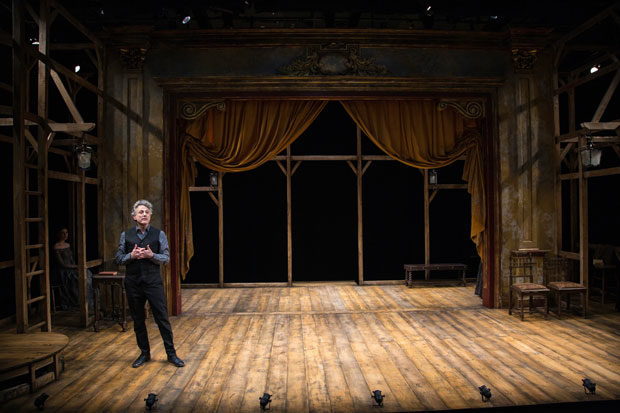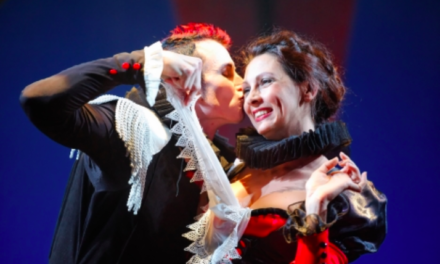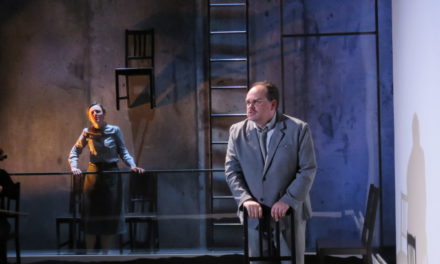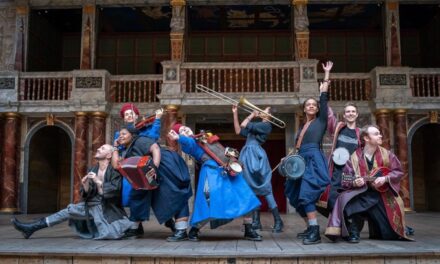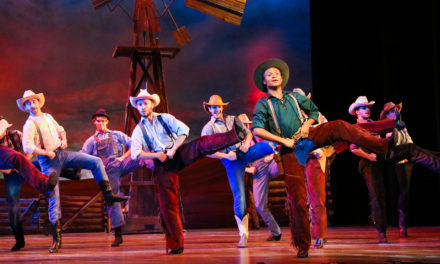David Greenspan keeps busy. Just two weeks after closing his monumental solo rendition of Eugene O’Neill’s Strange Interlude with the Transport Group he began rehearsals for New Saloon’s production of Milo Cramer’s new play Cute Activist at the Bushwick Starr. Then he was off to Two River Theater in Redbank, New Jersey to star in his own adaptation of Thornton Wilder’s The Bridge of San Luis Rey, in which he plays the “aged Harlequin” Uncle Pio, a charming, if disreputable, man of the theater described as resembling “a soiled pack of cards.” I recently met up with him at Caffe Reggio in Greenwich Village to talk about his rich and variegated career, sentiment, theatrical artifice, and death. While Greenspan’s creative life is an enviably fulfilling one, during our conversation he often alluded to the constant struggle to rack up enough weeks of Equity work to qualify for the actors’ union health insurance. While the notion that even an artist as accomplished as Greenspan should still have such concerns struck me as sorely unjust, he is philosophical about it. Quoting Pinocchio with neither bitterness nor appreciable gusto, “Hi-diddle-dee-dee,” he says, “The actor’s life for me.”
Your work is much admired for, among other things, its minimalism. In his introduction to the published volume of your plays, Marc Robinson writes that this commitment to minimalism springs from the conviction that “only by impoverishing the theater can one enrich the imagination.” You can certainly see this idea at work in The Bridge of San Luis Rey. In your role as narrator of the piece you often pause to call attention to the fact that we in the audience will have to do the work of imagining various events as they are described.
There’s a great artifice to the theater. Film tends to be experienced in a darker space. It’s only illuminated by the screen. In the theater there’s generally more spill. You know you’re in a theater. You know you’re watching something, even if it pulls you into a reality fully. There’s always a sense that you’re seeing something performed. I’ve always been attracted to the idea that by reducing, or impoverishing, the stage, you afford the audience an opportunity to use their imagination. I’m very bothered when things are too literal on stage. There are times when a play calls for a realistic set, but even with a realistic set you’re still imagining things. You’re imagining offstage rooms that people are coming from. Certainly in the things that I write and perform I like to have practically nothing so that the audience has to imagine everything.
Including sometimes, as in Strange Interlude, other actors. You’re a truly unique performer that way. Is it difficult to readjust to working as a member of a more traditional ensemble?
Not at all. It’s just beginning to study a new script. And learning a new part.
You’re also a little unusual in that you work across many different theatrical contexts, as a kind of sui generis solo performance impresario, with young Brooklyn-based theater companies, and at major regional theaters. Do you feel more at home in one of these spheres than in the others? Do you experience these different production models as being opposed in any way?
No. The process is generally the same. The resources might be different. But it’s all fine. There’s a wonderful line from Gertrude Stein’s lecture on theater. She’s speaking about apparent oppositions in plays, and she talks about things not necessarily being a contradiction, but a combination. And that’s really how I view the work. There aren’t really as many contradictions or differences. It’s more a combination of things that are similar or different that create a continuum, that create a career in the arts. And every opportunity is welcome because you never know. That’s the thing for actors. We all know it. The smallest opportunity can lead to any number of things. Every time you work, you’re increasing your chances of getting more work, and you really don’t know what it’s going to lead to. It always leads to something because you’re making friends. You’re developing collegial relationships with people. So it always leads to something. To more work. More relationships.
I’m glad you mentioned Stein. She and Thornton Wilder were great friends, and you’ve now worked on texts by both of them. Have you learned things about the one from the other? Does Stein influence your thinking about dramatic structure when working on a project like this?
With Stein I’m constantly learning. Her playwriting is so experimental. I mean she eschews action and story for what she calls time and emotion. Her aesthetics are much more radical and experimental than Wilder’s. But Stein influenced Strange Interlude, because I felt that one of the things I could accomplish in a solo rendition of that play was what Stein calls a “continuous present.” My understanding is that what she means by this is something like watching a film strip where you’re aware of constant movement, but you can pick out each individual frame. You’re always watching one thing at a time while somehow keeping up with the continuous movement of the film. And I thought that I could accomplish this because there was no one else to look at. You would only be watching one thing at one time while you were watching a continuous action, a continuous movement of characters and drama. So that was in the back of my mind. By comparison, Wilder is much more traditional. But he’s a great philosopher. There’s a pronounced theological aspect to his writing and a pronounced social and political aspect that wouldn’t be as pronounced in Stein.
Is the spiritual component of Wilder’s work something that appeals to you?
Oh sure. I put in a line in the middle of The Bridge of San Luis Rey, “That strain is Wilder’s constant refrain, how death must remain no matter how we dream away our lives, that death is constantly to our left.” I think he’s consistently interested in how quickly life passes, how we are not sufficiently aware, as is so evident in Our Town. How precious life is. How death is constantly around us. In Our Town people are dying constantly until in the last act all the dead people are there. This comes up in the last line of The Bridge. “We ourselves shall be loved for a while and forgotten,” Wilder says. There’s a great focus on death, on the ephemerality of life, its impermanence, its brevity. But what fascinates me and moves me is the fact that he’s really preoccupied with life and love, love in the most universal sense. It can be romantic love. But it’s more far reaching than that, encompassing spiritual love, love of life, love of other people. The idea of other people being life. That love transforms the brevity and impermanence of life into something cosmic, something eternal. I love the idea so much that I wrote it into my play I’m Looking for Helen Twelvetrees. The last lines were “The dead fall in silence, remembered for a time, until the last shadow that remembers them fades as well.” The idea that the moment of memory is enough. Wilder says that even memory is not necessary for love. Because that, too, is temporary. Still, the memory of somebody does influence people who have contact with that person until they, too, pass on. There’s always some influence, some impact. The past influences the present and the present influences the future. And those philosophical ideas move me emotionally, intellectually, and artistically.
I wanted to ask you about sentiment versus sentimentality in Wilder. He has a bit of a bad reputation because most people are introduced to his work by way of some cloying high school production of Our Town. But there are some very harsh truths articulated in The Bridge of San Luis Rey.
I don’t think Wilder is sentimental. The Skin of Our Teeth has very hard edges to it. War. Death. And Our Town is full of death, full of it, even to despair. Emily just despairs at the end that people don’t appreciate the wonder of life. I put a speech in the middle of The Bridge where I say to the audience, “Death is constantly to our left until the moment when it taps us on the shoulder. We turn our head and there we are. Dead. I paraphrase and I can’t recall the source. But you get my point.” I do it in a somewhat humorous way. But it’s also meant to be a somewhat harsh reminder that we’re all going to die. And we don’t think about it all the time. Maybe as you get older you do. I think I do more as I’ve gotten older. But you have to remember it, even though it’s a reality that can be frightening. Depending on how well you live and how much you think about life it may become less frightening. I think great people transcend the fear of death and do very heroic things. I think Wilder has an unsentimental view of life, and of unrealized dreams or dreams that are realized and don’t satisfy. One of the interesting things about The Bridge is that each character is on the verge of resolving aspects of their life before they fall. There’s great pathos and poignancy to that.
There’s one very brutal moment in the play when your character, Uncle Pio, is describing the purity of the love that he feels for his protégée, the actress Camila. She rejects him, saying that such love doesn’t exist. How close to Wilder’s heart do you think that sentiment is?
She says, “The love you’re describing only happens on the stage.” But that’s not true. Devotion. Sacrifice. Affection. They’re represented on the stage because I think they exist in life. I don’t think that Wilder would side with Camila. And I wouldn’t side with Camila in saying that the things that exist on the stage don’t exist in life. Both the fearful and the joyous that exist in art I think are representations of what we experience in life. I think Uncle Pio’s devotion to Camila, though complex, at times exploitative, at times brutal and unfair, is real. He feels a deep connection to her. He has a great need to teach. He has a great need to impart. And I think it speaks well of him.
What’s next for you?
I’m going to do a new play of mine called The Things That Were There, which is taken right out of Gertrude Stein. She’s talking about her landscape plays and she describes putting into those plays “the things that were there,” the trees, the magpies. It’s a fascinating idea, and it’s a memory play. I’ll do that at the Bushwick Starr, and then I’ll revive Minor Character: Six Translations of Uncle Vanya at the Same Time with New Saloon. So I’ve got work laid out through January. But I’m always climbing that hill, looking forward, counting my Equity pension and health insurance weeks, thinking “I’ve gotta get three more weeks by October,” that kind of thing. The actor’s life. I don’t think it’s changed much since people were trooping around with holes in their stockings in post-Restoration England, barnstorming. It’s always been that kind of life.
The Bridge of San Luis Rey
Adapted by David Greenspan
Directed by Ken Rus Schmoll
Two River Theater
Red Bank, New Jersey
Febuary 23-March 18, 2018
This post was written by the author in their personal capacity.The opinions expressed in this article are the author’s own and do not reflect the view of The Theatre Times, their staff or collaborators.
This post was written by Jessica Rizzo.
The views expressed here belong to the author and do not necessarily reflect our views and opinions.

